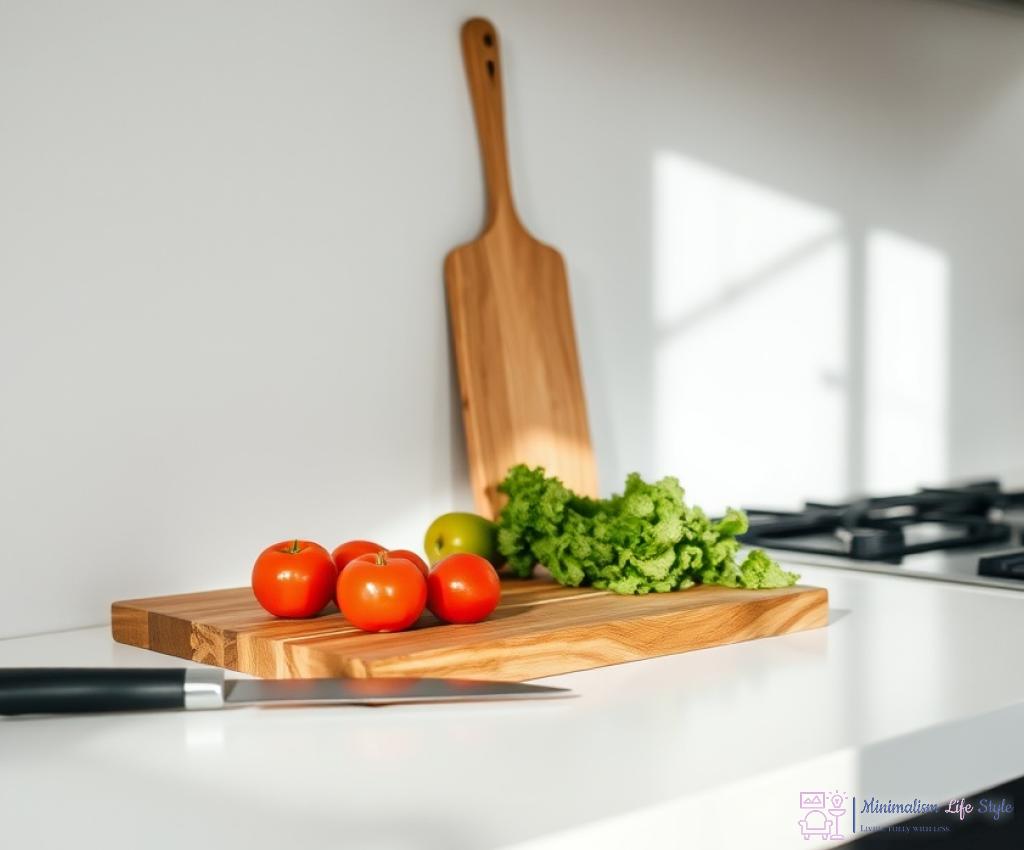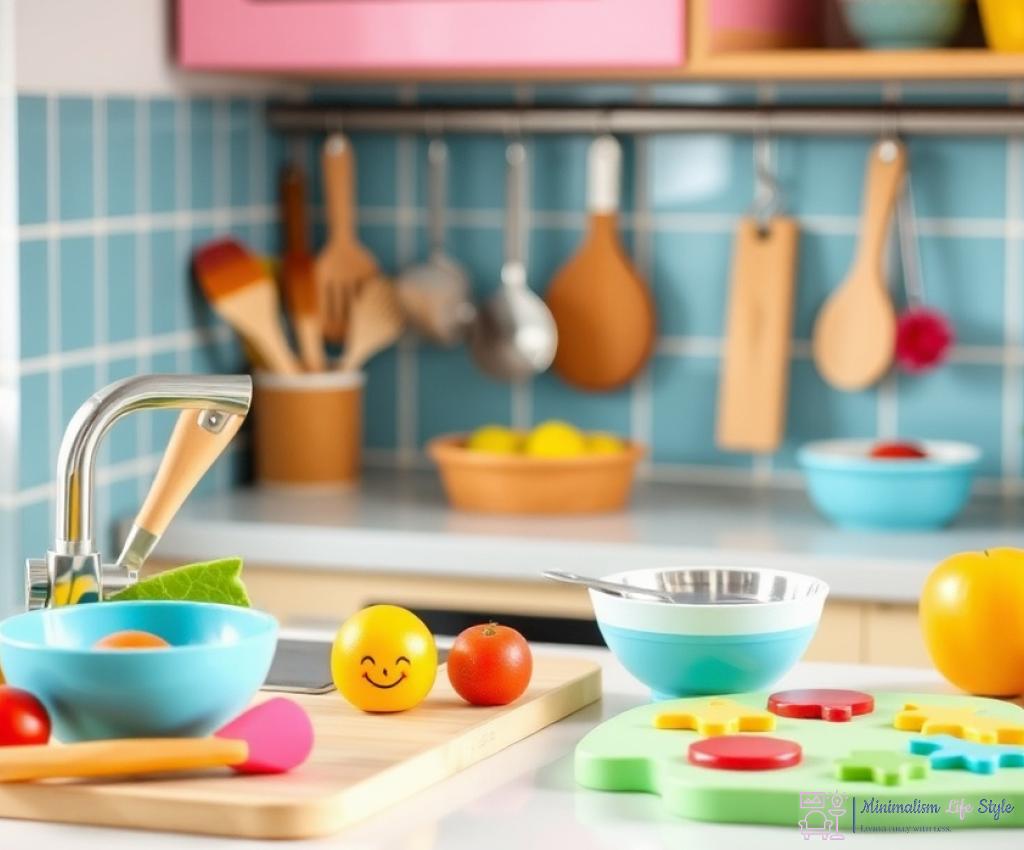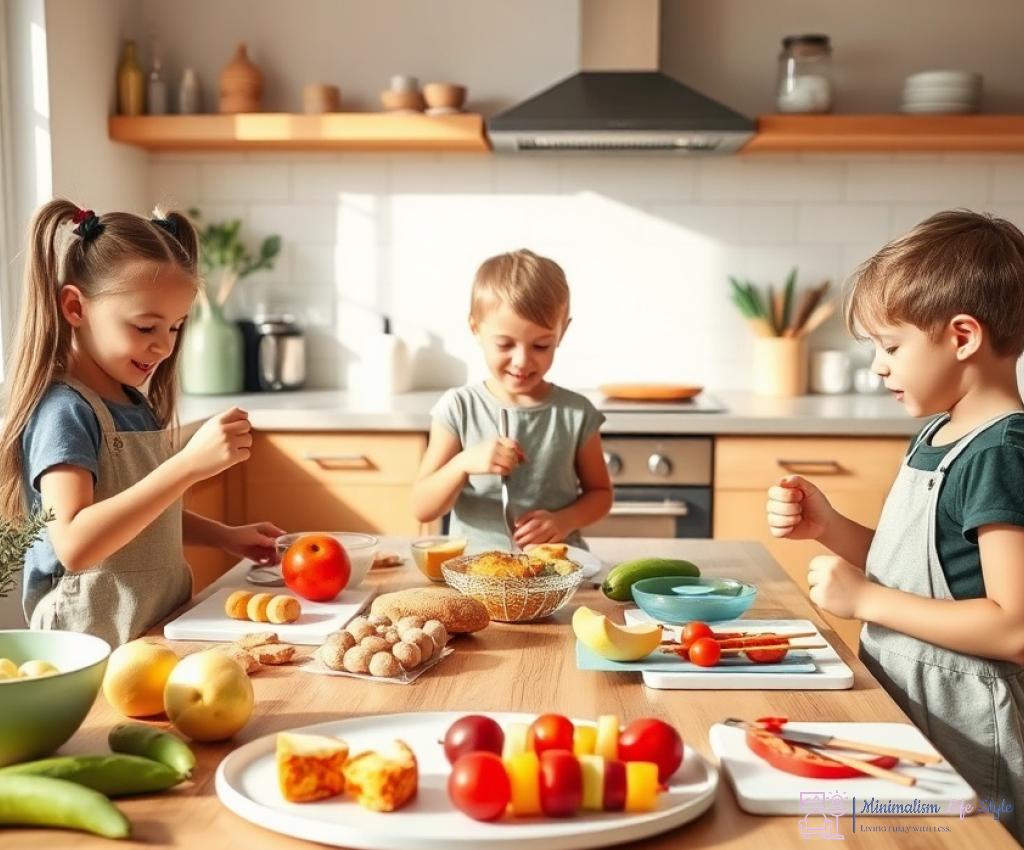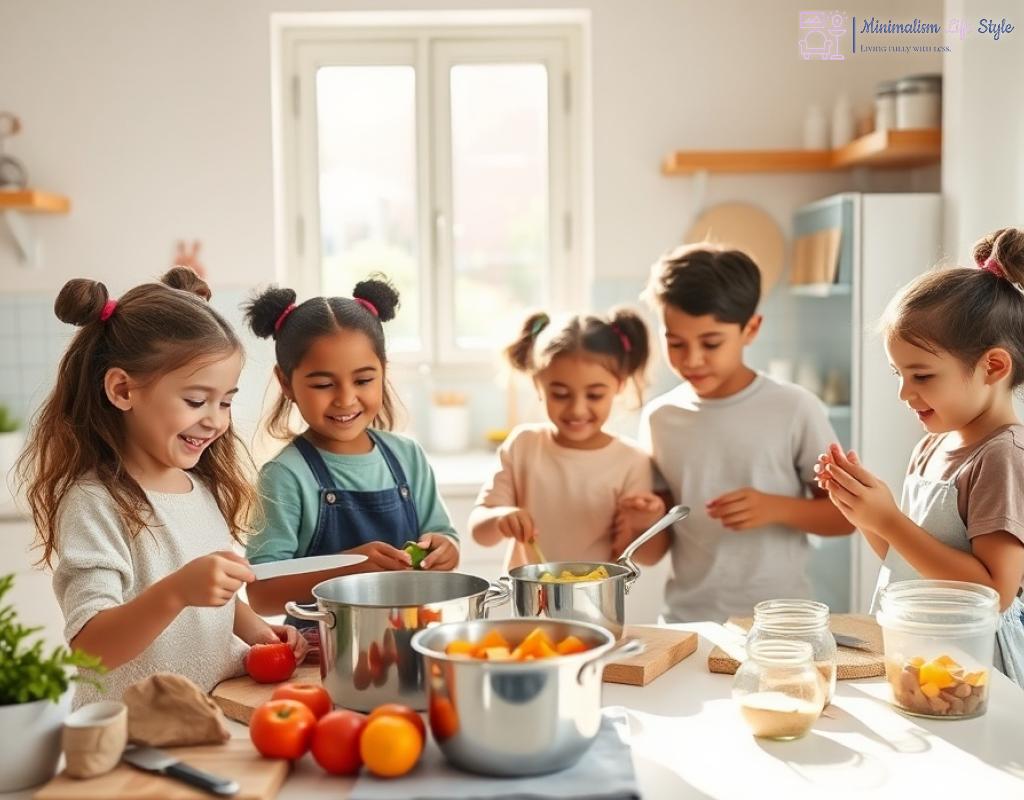Embracing Simplicity: The Basics of Minimalist Cooking

The Art of Cooking with Less
In a world overflowing with culinary choices, embracing minimalism in cooking can feel like a breath of fresh air. Teaching kids the joys of minimalist cooking not only simplifies meal preparation but also instills a sense of appreciation for quality ingredients and straightforward techniques. This approach encourages creativity, reduces waste, and fosters a deeper connection with food.
By focusing on essential skills and a few key ingredients, young cooks can learn to whip up delightful meals that are both satisfying and nourishing. Let’s explore how to embrace simplicity in the kitchen!
Essential Ingredients: The Foundation of Minimalist Cooking
At the heart of minimalist cooking lies a well-curated selection of ingredients. Rather than overwhelming kids with a pantry full of exotic items, teaching them to focus on a few versatile staples can yield delicious results. Here are some common ingredients that can serve as the building blocks for countless meals:
- Fresh vegetables (carrots, bell peppers, spinach)
- Whole grains (rice, quinoa, oats)
- Proteins (beans, eggs, chicken)
- Herbs and spices (basil, garlic, salt, pepper)
- Healthy fats (olive oil, butter)
With these ingredients on hand, kids can learn to create a variety of dishes while understanding the importance of balance and flavor.
Simple Techniques: Mastering the Basics
The beauty of minimalist cooking lies in its simplicity. By honing a few fundamental skills, kids can build their confidence in the kitchen and develop a lifelong love for cooking. Here are some essential techniques that every young chef should master:
- Chopping: Learning to chop vegetables efficiently is crucial. Teach them to use a knife safely and practice different chopping techniques.
- Boiling: Mastering the art of boiling pasta or grains is foundational. Show them how to achieve the perfect texture.
- Sautéing: This technique allows kids to enhance flavors by cooking ingredients in a little oil over medium heat.
- Baking: Introduce simple baking recipes like muffins or cookies that require minimal ingredients.
By focusing on these core skills, children will gain the confidence they need to experiment with their culinary creations, all while understanding that less can truly be more when it comes to cooking.
Essential Tools for Kid-Friendly Culinary Adventures

Creating a Kid-Friendly Kitchen Environment
When it comes to teaching children the art of cooking, the tools they use play a crucial role in their culinary journey. A well-equipped kitchen can transform the experience from daunting to delightful. By focusing on a few essential tools, parents can empower their young chefs to explore and experiment without feeling overwhelmed. It’s not just about having the right equipment; it’s about fostering independence and creativity in the kitchen.
The Must-Have Kitchen Tools for Young Chefs
Equipping your kitchen with kid-friendly tools is essential for making cooking both fun and safe. Consider the following items that can enhance the experience:
Child-Safe Knives: Investing in specialized child-safe knives can help kids learn the fundamental skill of chopping without the risk of injury. These knives typically feature rounded edges and are designed for little hands, encouraging confidence as they prepare ingredients.
Measuring Cups and Spoons: Precision is key in cooking, and having a set of colorful measuring cups and spoons can make this process enjoyable. Kids will not only learn about measurements but also gain a better understanding of proportions and ratios, essential concepts in culinary arts.
Mixing Bowls: A variety of mixing bowls in different sizes will allow children to tackle a range of recipes. Opt for lightweight, non-slip bowls to make handling easier. This simple tool can make a world of difference in mixing ingredients efficiently and mess-free.
Aprons and Oven Mitts: Protecting young chefs from spills and burns is paramount. Providing them with fun, colorful aprons and child-sized oven mitts not only adds to the excitement but also instills a sense of responsibility and care for their cooking environment.
Understanding the Importance of Each Tool
Every tool in the kitchen serves a distinct purpose, contributing to a child’s overall cooking education. From slicing and dicing to measuring and mixing, each activity enhances different skills. It’s essential to emphasize that using these tools can be a learning experience in itself. For instance, while using measuring cups, kids not only grasp the concept of volume but also practice math skills in a practical setting.
Furthermore, integrating these tools into cooking lessons promotes a sense of ownership and accomplishment. Children will find joy in mastering the use of their kitchen tools, which encourages them to take pride in their creations. By cultivating a positive relationship with cooking tools, children are more likely to develop a lifelong passion for culinary arts.
Fun and Easy Recipes to Spark Creativity in the Kitchen

Cooking should be an adventure, especially for young chefs eager to explore their culinary creativity! Minimalist cooking shines when it comes to easy recipes that use a handful of ingredients, allowing kids to experiment without the stress of complexity. Here, we’ll dive into a selection of fun and engaging recipes that not only simplify the cooking process but also ignite imagination in the kitchen.
Colorful Veggie Wraps: A Canvas for Creativity
These wraps are not just a meal but a colorful canvas for kids to express themselves. Using whole grain tortillas, let children choose their favorite fillings from a selection of fresh vegetables and proteins. They can mix and match ingredients, creating their unique flavor combinations. Here’s a simple guide to make these veggie wraps:
Ingredients: Whole grain tortillas, hummus, bell peppers, carrots, spinach, shredded chicken (optional).
- Spread a generous layer of hummus on the tortilla.
- Add a colorful mix of sliced vegetables and proteins.
- Roll the tortilla tightly and slice it into pinwheels or halves.
- Arrange on a plate and enjoy!
This recipe not only promotes healthy eating but also encourages kids to visualize their meals, turning them into little culinary artists!
One-Pan Pasta: Simplicity at Its Best
One-pan pasta dishes are perfect for teaching kids the beauty of minimalist cooking. With minimal cleanup and maximum flavor, this recipe allows for creativity with just a few ingredients. Here’s how to whip up a delightful one-pan pasta:
Ingredients: Whole wheat pasta, cherry tomatoes, garlic, spinach, olive oil, salt, and pepper.
- In a large pan, combine uncooked pasta, halved cherry tomatoes, minced garlic, and spinach.
- Add enough water to cover the ingredients and a drizzle of olive oil.
- Bring to a boil, then reduce heat and simmer, stirring occasionally until the pasta is cooked.
- Season with salt and pepper, and serve warm.
This dish empowers kids to take control of their cooking while appreciating the simplicity of combining fresh ingredients into a hearty meal.
Sweet Banana Oat Cookies: A Healthy Treat
For a sweet ending, these banana oat cookies are a hit! With just three main ingredients, they are not only easy to make but also allow kids to experiment with flavors by adding nuts or chocolate chips. Here’s how to create these wholesome treats:
Ingredients: Ripe bananas, rolled oats, and cinnamon.
- Preheat the oven to 350°F (175°C).
- In a bowl, mash the ripe bananas until smooth.
- Stir in rolled oats and a sprinkle of cinnamon.
- Drop spoonfuls of the mixture onto a baking sheet and bake for 10-12 minutes.
These cookies are a fantastic way for kids to learn about healthy baking while enjoying the process of creating something delicious!
Mindful Eating: Teaching Kids to Appreciate Food
In the journey of teaching children the art of minimalist cooking, one of the most profound lessons they can learn is the value of mindful eating. This concept extends beyond the act of consuming food; it encourages kids to cultivate a deeper connection with what they eat. By fostering an environment where they not only prepare but also appreciate their meals, young cooks can develop an understanding of nourishment that transcends mere sustenance.
Engaging kids in the process of mindful eating begins with teaching them to recognize the flavors, textures, and colors of their food. When children actively participate in meal preparation, they become more aware of the ingredients that go into their dishes. This awareness promotes a sense of gratitude for food, making them less likely to waste it. As they learn to appreciate quality over quantity, children can develop a more discerning palate, which is essential in embracing the minimalist cooking philosophy.
Exploring the Journey of Food
To truly appreciate food, it helps for children to understand the journey that ingredients take from farm to table. By discussing where their food comes from, kids can gain insight into the hard work that goes into producing it. Activities such as visiting local farms, attending farmer’s markets, or even growing herbs at home can significantly enhance this learning experience. When children see the source of their food, they are more likely to value and savor every bite.
The Joy of Sensory Exploration
Encouraging kids to engage their senses while eating can transform mealtime into a delightful adventure. Teach them to observe the vibrant colors of fruits and vegetables, the diverse textures of grains, and the aromatic spices that enhance flavors. By inviting children to describe their food using sensory language, they become more invested in their meals. For instance, ask them to identify the sweetness of a ripe strawberry or the crunchiness of a fresh carrot. This practice not only makes eating more enjoyable but also strengthens their vocabulary and comprehension of flavors.
Furthermore, incorporating peaceful eating practices, such as eliminating distractions and taking the time to chew slowly, can enhance their overall dining experience. Discussing the importance of gratitude before meals can also foster a respectful attitude toward food. Such habits will not only encourage a mindful eating approach but will also promote healthier eating patterns as they grow older.
| Benefits of Mindful Eating | Impact on Cooking |
|---|---|
| Enhances appreciation for ingredients | Encourages selecting quality over quantity |
| Reduces food waste | Promotes thoughtful meal planning |
| Fosters healthier eating habits | Inspires creativity in meal preparation |
In conclusion, teaching kids about mindful eating is an essential element of cultivating a minimalist cooking mindset. By nurturing their awareness of food, fostering sensory exploration, and encouraging gratitude, parents can help their children develop a profound appreciation for culinary arts that will last a lifetime. Ultimately, this journey not only creates confident young chefs but also instills a love for wholesome, nourishing food.
Cleaning Up: Instilling Good Habits in the Kitchen
In the world of cooking, the joy of creating delicious meals is often accompanied by the responsibility of maintaining a clean and organized kitchen. Teaching children to embrace cleanliness as part of their culinary experience will instill valuable habits that extend beyond the kitchen. It is essential to emphasize that cooking is not just about the food; it also encompasses the environment in which that food is prepared and enjoyed. Establishing a routine of cleaning up can enhance the cooking experience and foster a sense of pride in their culinary creations.
Creating a Culture of Cleanliness
Encouraging kids to view cleaning up as an integral part of the cooking process can transform their attitude towards chores. By introducing the concept of a clean kitchen being a happy kitchen, children can learn to associate cleanliness with positive feelings. Start by making clean-up time a fun activity rather than a tedious task. Engage them in a playful manner by turning it into a game—who can put away the most items in a minute? This creates a sense of teamwork and accomplishment that will motivate them to take ownership of their space.
Establishing Routine Cleaning Habits
To reinforce good habits, establish a cleaning routine that complements the cooking process. Before starting to cook, discuss the importance of having a tidy workspace. As they cook, encourage them to clean as they go. For example, suggest rinsing cutting boards and utensils immediately after use. This approach not only keeps the kitchen organized but also minimizes the overwhelming task of cleaning up after the meal is complete. After every cooking session, allocate a few minutes to reflect on the cleaning process together; ask them what worked well and what could be improved. This reflection will encourage critical thinking and a proactive mindset towards maintaining cleanliness.
The Benefits of a Clean Kitchen
Instilling these habits not only creates a pleasant cooking environment but also enhances the overall culinary experience. A clean kitchen promotes safety by reducing the risk of accidents and cross-contamination, especially when working with raw ingredients. Moreover, it fosters a sense of respect for the cooking process and the ingredients involved. Children will learn that every meal deserves a clean slate, paving the way for mindfulness in the kitchen. As they grow, these habits will become second nature, leading to a lifetime of responsible cooking practices.




